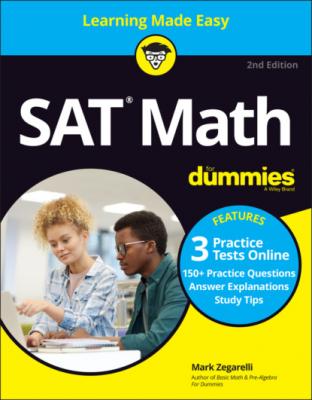SAT Math For Dummies with Online Practice. Mark Zegarelli
Чтение книги онлайн.
Читать онлайн книгу SAT Math For Dummies with Online Practice - Mark Zegarelli страница 20
 the order of operations, affectionately remembered as PEMDAS), you’re well on your way to a complete mastery of arithmetic. In fact, you may already be a winner.
the order of operations, affectionately remembered as PEMDAS), you’re well on your way to a complete mastery of arithmetic. In fact, you may already be a winner.
In contrast, algebra takes arithmetic one step further by introducing the variable, which is often named x. Algebra is the place that some of the nicest people you will ever meet — possibly, your parents — threw in the towel on math. And then, when they meet me at a party (yes, math teachers sometimes go to parties), they say, “OMG, I could never learn algebra!”
I feel their pain. At the same time, even though using variables can be tricky, there is no law that says arithmetic is always easier than algebra. For example:
| Arithmetic Problem | Algebra Problem |
|---|---|
|
|
|
You can probably see that in the algebra problem shown here, the value of x is 4. In contrast, the answer to the arithmetic problem is left for the reader to solve (which is a fancy way teachers get to pose hard questions without having to answer them!).
The take-away here is that arithmetic is math that involves numbers and operations on them, and algebra includes variables.
Equations, identities, and inequalities
An equation is any valid mathematical statement that includes an equals sign (=). For example:
|
|
|
|
One of the key tasks in algebra is to solve equations. Usually, that means discovering the value of the variable in that equation.
In some cases, an equation is true for all (or just about all) values of the variable. An equation like this is called an identity. For example:
|
|
|
|
The first two identities are true for all values of x. The third is true for all values of x except 0, because a value of 0 in the denominator is not allowed. Identities can be helpful because they allow you to rewrite, and even rethink, an equation in a different and potentially more helpful form.
Finally, an inequality is a valid mathematical statement that includes one of four inequality operators: less than (<), greater than (>), less than or equal to (
|
|
|
|
|
You can’t usually solve an inequality for a specific value, as you can with an equation. Rather, an inequality is usually solved for a solution set — that is, a set of values that satisfy the inequality. For example, the solution set for the first inequality is (
Expressions
An expression is any string of mathematical symbols that you can place on one side of an equation, identity, or inequality. For example, consider this equation from the last section:
This equation includes two expressions:
As a mathematical concept, expressions often get lost in the shuffle when students are struggling to learn algebra. If you can, try not to let that happen as you revisit algebra while studying for the SAT. Think of it like this:
An expression doesn't have an equals sign (=). Expressions are evaluated, simplified, or factored, but not solved.
An equation is two expressions joined with an equals sign. Equations are to be solved.
In Chapter 3, you work extensively with expressions. In this section, I discuss a few more math words that help you to break down and understand expressions better.
Variable and constant terms
Every expression is built from one or more terms, separated by either plus signs or minus signs.
Table 2-2 illustrates this concept, showing expressions with from one to four terms.
TABLE 2-2 Expressions with 1, 2, 3, and 4 Terms
| Expression | Number of Terms | Terms |
|---|---|---|
|
|
1 |
|
|
|